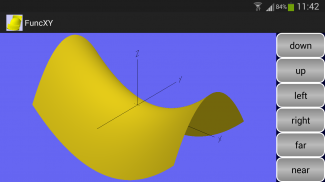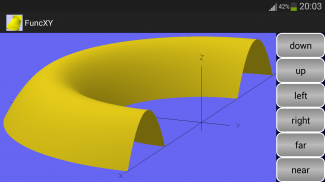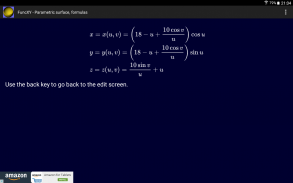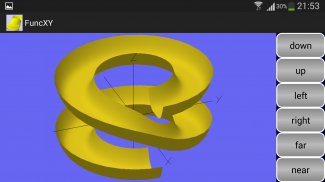


























FuncXY

وصف لـFuncXY
FuncXY هو تطبيق لرسم الرسوم البيانية 3D وظائف اثنين من المتغيرات. في أبسط الحالات، وهذه هي الإحداثيات x و y الديكارتي. الإصدار 2.00 أسطواني قدم إحداثيات ثيتا وص كبديل. تمديد آخر، وذلك باستخدام الإحداثيات الكروية ثيتا وفاي، تتوفر في الإصدار 2.03 أيضا. وأخيرا، الإصدار 2.06 كما يدعم السطوح حدودي.
يمكنك إدخال صيغة الدالة التي تريد رسمها. هذا يجب أن يكون تعبير في اثنين من المتغيرات، التي لديك الآن أربعة خيارات، وهذا يتوقف على نوع من الإحداثيات:
الإحداثيات الديكارتية x و y، أو
أسطواني تنسق ثيتا و r، أو
الإحداثيات الكروية ثيتا وفاي، أو
السطوح حدودي مع الإحداثيات u و v، التي يتم التعبير ليس وظيفة واحدة بل X و Y و Z.
يمكنك استخدام العوامل الحسابية + - * / و ^ (لالأسية). يمكنك إضافة أقواس بالطريقة المعتادة. ويسمح للمسافات فارغة. يجب أن يتم توفير القيم الدنيا والقصوى للالمتغيرين. في حالة وجود أخطاء في بناء الجملة أو القسمة على الصفر، لم يتم قبول التعبير. كما يمكنك إدخال صيغة، يتم عرضها في تدوين أكثر قابلية للقراءة فقط فوق النص الذي تدخل أو التحرير.
السطح وظيفة يمكن أن ينظر إليها من أي جهة. هناك أزرار لتغيير وجهة نظر ولكن يمكنك أيضا تغيير اتجاه العرض عن طريق تمرير الصورة، وهذا هو، عن طريق تحريك إصبعك على الشاشة إما أفقيا أو عموديا. يمكنك أيضا تحديد اتجاه عرض عن طريق إدخال زاويتين phiE وthetaE، كما هو موضح في التطبيق نفسه.
في صورة 3D، يمكنك عرض أو إخفاء المحاور تنسيق كما تريد، عن طريق مربع على الشاشة الاختيار. يمكنك عرض هذه الشاشة الاختيار عن طريق استخدام مفتاح العودة.
الوظائف التالية، والمعروف جيدا في الرياضيات أو البرمجة، معتمدة:
وتقاسم المنافع، والكلمة، سقف، إكسب، تسجيل، كحد أقصى، ودقيقة، والخطيئة، كوس، تان، آسين، ACOS، عطان، الجذر التربيعي. يمكنك أيضا استخدام باي المستمر.
يجب أن تكون محاطة الحجج التي قوسين. على سبيل المثال، الخطيئة (خ)، لا ذنب س. وكما جرت العادة، والحد الأقصى والحد الأدنى اتخاذ حجتين، والبعض الآخر يأخذ واحدة. لاحظ المجالات المقيد لبعض هذه الوظائف:
تسجيل (خ): س إيجابية.
تان (خ): س لا تساوي بي / 2 (بالإضافة إلى أي مضاعفات بي)؛
آسين (خ)، ACOS (خ): س -1 و +1 بين (ضمنا).
لكل من تنسيق أربعة أنواع، وهناك بعض الأمثلة المتاحة في قائمة الخيارات. عندما اخترت على سبيل المثال، يتم اختيار النوع المطلوب الإحداثيات تلقائيا، بحيث لا تحتاج إلى عناء عن هذا الاختيار. بعض من هذه الأمثلة تبين تنسيق محاور بينما البعض إخفائها. في مربع على الشاشة خيار تمكنك من تغيير هذا الوضع.
وظيفة محددة يمكن حفظ واسترجاع لاحقا. ثم يتم أيضا حفظ بيانات التالية تلقائيا واسترجاع: فترات تنسيق، وجهة نظر معلمات phiE وthetaE، والدولة من مربع لعرض المحاور.
في الإصدار 2.07 وأعلى، معتمدة التعبيرات الشرطية. هذه هي معروفة في لغات البرمجة ويكون على شكل "تعبير منطقي التعبير 1: 2 التعبير". على سبيل المثال، الحد الأقصى التعبير (س، ص) يمكن أن يكتب كما التعبير الشرطي: (؟ س> ص س: ص). وإلى جانب "؟" و":" الأحرف التالية يمكن الآن أن تستخدم أيضا: "<"، ">"، "=" "&"، "|" "1". يمكنك استخدام "=" أو كما في لغات البرمجة الحقيقية، "==" لاختبار إذا تعبيرين على قدم المساواة. وبالمثل، "&" و "|" (يعني 'و' و 'أو') يمكن أن تظهر مفردة أو مزدوجة، مع نفس المعنى. علامة التعجب "!" لتقف على 'لا'. لذلك، "س> ص" ويمكن أيضا أن تكون مكتوبة "! (خ <= ذ)". وبالمثل، "! (خ == ذ)" له نفس معنى "س! = ذ"، على حد سواء تدل 'X غير متكافئة لذ'. على سبيل المثال المدمج في 2 يوضح تعبير شرطي متداخلة مع الجزء التالي ":" تحتوي على التعبير الشرطي آخر.
يرجى الرجوع أيضا إلى
http://home.kpn.nl/ammeraal/funcxy.html

























